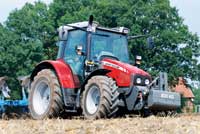Tractor test: Massey Ferguson 5445

Class-leading visibility, a sophisticated but simple-to-operate transmission and roomy cab make the MF a real all-rounder – although the engine turned out to be thirsty.
Engine 5/10
The Perkins engine here was the only one in the group with power boost, however it could not be turned off. This affected pto measurements, and not always positively. At rated rpm the engine gulped 314g/kWh of diesel, the highest figure in the test.
With 98hp peak performance, the MF is the strongest pto performer although here, too, it’s not exactly frugal with a consumption figure of 282g/kWh. The pattern continued with the 6-point measurement where 46g separated this tractor from the best.
But this is an engine with really impressive torque and it scored high marks for constant power range (36%), torque rise (61%) and a starting torque of 158%.
Draft performance was 68hp with specific fuel consumption 7% above group average. The consumption improved at maximum draft with 326g (Average = 321g/kWh).
Transmission 8/10
The Dyna-4 transmission has four main gears grouped within four ranges, giving a total of 16F x 16R ratios, seven of them between 4 and 12kph. There’s a disadvantage here when ploughing, though – the ranges don’t overlap.
All range and gear changes are handled by a single silver-topped T-bar lever. Nudge it forwards for higher gears and back to drop a cog. For range changes, press a button on the lever and move it forwards or back. No jerks are involved, unless you’re under load.
The lights for range and gear selection are split between the dashboard and the gear stick. It would be better to have a single common indicator display mounted on the A-pillar.
Along with clutching and direction changes, powershift steps and ranges can be changed – all with the left hand. Once the top powershift speed is reached, a bleep sounds. You then push the clutch and move the shuttle lever in the required direction and the transmission changes into the next range.
With every range change, the appropriate powershift range is found. Although the hardware is there, MF unfortunately offers no automatic. Especially good is the ability to adjust harshness of shuttle action via a dial beside the T-bar lever.
Cab 9/10
The MF cab is comfortable, unspectacular, roomy and quiet (75 dB(A)). This is a tall tractor at 2.8m, although there is an option for a lower 2.56m cab.
There’s ample legroom and the simple passenger seat is surprisingly comfortable. This machine’s mean with storage though. That’s not a criticism you could level at the ergonomics – these are simple controls, well laid-out.
At the business end there are two double spotlights in the roof, a further two on the grab-rails and another pair of double spots at the rear.
We were less chuffed with the air conditioning, which struggled to keep temperatures down in the warm August weather.
As far as visibility is concerned, the MF is the out-and-out winner, thanks to its steeply sloping bonnet. Above, there’s a large, tinted skylight that can be shoved open all the way to the rear, which is ideal.
Hydraulics 8/10
Top-link draft sensing works well when ploughing – as long as it’s not in a headstock slot. The linkage lifts an average of almost 5t – the second best on test, though lift distance is not so impressive at 56cm.
Electronic controls on the MF are practical, with dials for mix control, drop-rate and lift height. The range for drop-rate is too limited – the slightest turn too far means the implement comes down with a bang. The problem disappears if the knob is turned to automatic.
Exterior buttons only work with the main controls activated and the main switch in the N position, something that’s easily forgotten when climbing down to hitch up an implement.
With 57 litres/min capacity, oil supply is unimpressive and for more hydraulic oomph there’s an optional auxiliary pump. For this, you first activate the linkage and then press the pump rocker switch which once again deactivates the linkage. Then oilflow rises to a powerful 101 litres/min.
Pto 9/10
Four pto speeds are provided – one lever selects 540 or 1000 rpm and the other engages “normal” or “eco”. The levers are not, however, grouped together and are also a little stiff.
The switch has three positions: Brake, off and on. If you don’t watch out you can slip very easily into the brake position when aiming to just switch off.
The optional linkage-dependent automatic mode is activated by press-button. There’s an exterior control on the left-hand side although it’s quite a stretch around the side to get to it.
4WD/diff-lock 8/10
A short jab on the four-wheel-drive switch activates automatic mode which switches the drive off when forward speed hits 14kph (not ideal for jobs like mowing). Pressing the switch for more than two seconds keeps the four-wheel-drive on permanently.
The diff-lock is automatically deactivated or activated again when the linkage controls are used. It is completely disengaged at over 14kph or when braking.
Driving comfort 8/10
Lock-to-lock involves just four turns of the steering wheel, which is fine although height adjustment is awkward. The winkers lack self-cancelling.
The precise steering and respectable wheelbase of 2.46m mean the 5445 handles well on the road.

